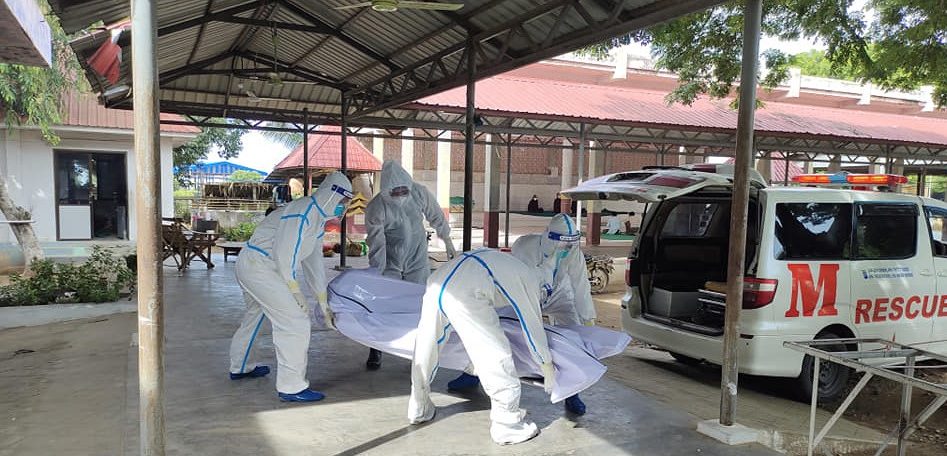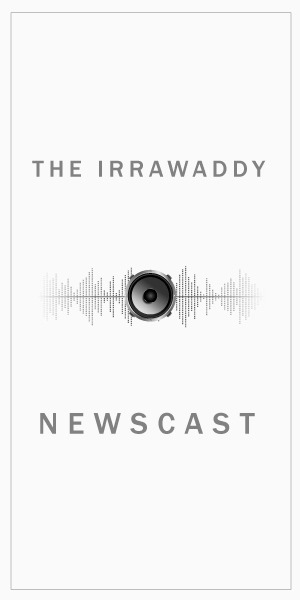Myanmar is now a country which has been severely hit by two Cs—the coup d’état and COVID-19. Both Cs are cruel, but the former made the latter worse.
Ambulance sirens wake people up in Yangon these days. The sounds also convey the sorrows and worries of many residents of Myanmar’s biggest city with a population of more than 7 million.
Since early July, I’ve noticed an alarming increase in the frequency of sirens and even in the urgency and speed with which the ambulances drive. Last week, I started seeing more of them, sometimes up to six or seven ambulances in a row speeding to and fro, blasting sirens continuously and honking at blocked traffic. It doesn’t stop all day long.
From my apartment, which is on one of Yangon’s main roads, I can observe medics and drivers wearing PPE inside the ambulances. Even when I am in bed or in the kitchen, I hear their sirens from dawn to 10 pm, when the curfew is imposed by the military regime to curb protesters’ anti-coup activities.
On Monday, the regime reported 89 fatalities across the country. But the real death toll is believed to be higher.
Take a look at the death toll in Kale Township in Sagaing Region. In just the first week of July, 207 people are believed to have died from the virus, according to volunteers and residents. And they also said that around 400 have died in the township in the last month. But the regime’s Health Ministry announced only six deaths during the first week of July and 11 deaths for the last two weeks of June in the township.
So far, nearly 90 percent of the country has been affected by the country’s third wave of coronavirus infections since May, with nearly 300 of 330 townships across the country reporting cases.
Many friends and colleagues of mine have fallen sick over the past few weeks and some of them have tested positive. But most of them, like countless other patients. couldn’t go to hospitals, as there are no proper mechanisms and procedures in place in the public health sector. Many people are desperately searching for oxygen for family members with COVID. Almost everywhere, people are lining up with oxygen cylinders wherever it might be available. But the regime recently banned people from buying oxygen themselves. That has made people panic more, causing chaos in Yangon and elsewhere.
People are helpless. They all, including my friends and colleagues, have been taking care of themselves as the public healthcare system has collapsed.
This is a consequence of the military coup led by Senior General Min Aung Hlaing on Feb. 1. Systematic mechanisms disappeared right after the elected civilian government led by popular leader Daw Aung San Suu Kyi was removed and all leaders of the government thrown behind bars or under house arrest.
The coup, which shocked many in Myanmar as well as the world, overturned all the structures of the country—its fledgling democratic reform, economy and so on. Now we’ve seen how terribly the healthcare system has failed.
The coup has faced strong protests from the public nationwide. But the coup leaders are ruthless. So, the people—ordinary activists, politicians and people of all professions who are against the regime—have since then faced brutal killings, shootings and arrests by the regime. So far, the regime’s soldiers and police have killed nearly 900 people, including dozens of children, and detained thousands of anti-coup protesters and politicians, including elected members of the parliaments and the ousted government’s ministers. Many people have gone into hiding as the regime issued arrest warrants and tried to arrest them arbitrarily.
Health workers, including doctors and nurses, across the country are among them. The military has issued arrest warrants for 400 doctors and 180 nurses due to their participation in the civil disobedience movement (CDM) against the coup, according to the US-based Physicians for Human Rights. Between the coup and July 6, at least 157 healthcare workers were arrested, 32 wounded and 12 killed, the group said. But many more health workers are still taking part in the CDM against the regime.

The people of Myanmar still face killings and arrests by the regime. The entire population of 54 million has been hit by the first cruel C—the coup d’état.
Now they are being hit by the second cruel C—COVID-19, or the coronavirus.
But the people wouldn’t have suffered to this degree unless the military had created the first C—the coup d’état.
Myanmar is a poor country, but the ousted civilian government proved that being poor doesn’t really matter if good governance and public trust are established, when it comes to tackling even the deadly global pandemic of COVID-19 during its first and second waves last year. We can still recall reports of how terribly people were suffering at that time in rich and developed countries like the United States, as well as Britain and other countries in Europe.
The ousted government of Myanmar proved that a poor country can tackle the pandemic with seriousness and good management, with the full collaboration of the public and health workers from the national level to the community level.
“Myanmar has done extraordinarily well so far,” said a representative of the World Health Organization (WHO) in Myanmar in an interview with The Irrawaddy last year, when asked for his assessment of the country’s COVID-19 response under Daw Aung San Suu Kyi’s government.
Dr. Stephan Paul Jost said the country had taken a “whole-of-government” approach, implementing such measures as suspension of flights, mass gatherings, partial lockdowns in all parts of the country, and more. He also said that those measures “were examples of how the county has really gone all out to strengthen the public health side and preparedness and response.”
By now, however, all such mechanisms have disappeared with the military’s takeover. Sadly, Myanmar people got the worst possible ruler for this most dangerous, once in a century pandemic.
Actually, this regime led by Min Aung Hlaing has already proved in just a few months that he has no ability to run the country at all. Instead, he has surpassed the miserable incompetence of even his former bosses, the previous military dictators, in all aspects: politics, economics, education, health and everything else. That’s why the people of Myanmar see him as the worst among the dictators of this country.
When it comes to fighting the third wave of COVID, many people have expressed their political feeling on social media: “We need a revolution to fight the coup, while we need oxygen to fight COVID.” It shows their determination that they will succumb to neither the coup nor COVID.
Politics is everything. When a political system or its stability is destroyed, almost everything else collapses.
Some apologists for the regime have been arguing that health workers who have joined the CDM should reinforce hospitals and clinics now that the country has been hit by the third wave of COVID-19. They couldn’t do that, as many of them are wanted by the regime.
And many users of Facebook have responded that if Min Aung Hlaing relinquished power and released Daw Aung San Suu Kyi, all people, not only health workers but also volunteers and rich businessmen who donated millions of dollars to build centers across the country for COVID patients under the previous government, will come back tomorrow to fight the third wave of COVID, as they did before.
That’s their response and it’s what they really want to see. But it is wishful thinking.
In reality, Myanmar is facing a nasty regime and an ugly pandemic at the same time.
Myanmar, however, is resilient after having survived several dark ages—a century of colonial rule from the 19th century, more than 70 years of civil war after 1948 and more than half a century of military rule after 1962.
Naing Khit is a commentator on political affairs.
You may also like these stories:
Nearly 1,200 Coronavirus-Positive Myanmar Workers in Thailand’s Tak Need Help, Groups Say
Myanmar Border Town Locked Down by KIA as New COVID-19 Infections Emerge
The Coup China Saw Coming in Myanmar—and Failed to Stop
















